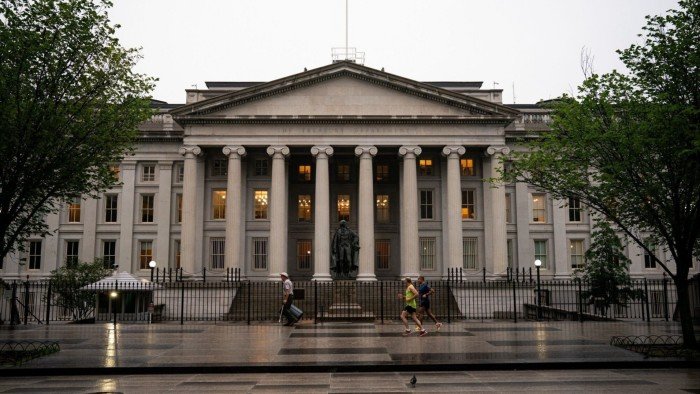Get the White House Watch newsletter for free
Your insight into the implications of Trump’s potential second term for Washington, the economy, and the globe
Despite significant volatility in the Treasury market caused by Donald Trump’s “liberation day” tariff announcement, foreign investors’ holdings of US government debt saw only a slight decline in April.
According to a report from the Treasury Department on Wednesday, international holdings dropped by $36.1 billion from the previous month, totaling nearly $9 trillion—just below the all-time high reached in March.
The announcement on April 2 regarding hefty tariffs on trade partners resulted in substantial market fluctuations, causing long-term US bond yields to spike. However, this reaction was somewhat muted after the president delayed the tariffs a week later.
The small decrease in foreign holdings indicates that international investors did not leave the market in droves, as some analysts had anticipated. This is significant, as Treasury debt generally acts as a safe investment during global uncertainties.
Foreign entities hold about one-third of all Treasury bonds, and their appetite for US debt has enabled the country to finance its government for years without substantially increasing taxes or cutting spending.
China’s Treasury holdings have fallen to the lowest point since 2009, totaling $757 billion. Conversely, Belgium’s Treasury holdings—often viewed as a proxy for China’s investments abroad—increased. Canada experienced the largest reduction, shedding $57.8 billion worth of Treasuries. Meanwhile, Japan and the UK, the two top holders of US debt, expanded their investments.
The Treasury data does not reflect fluctuations in the market value of these securities throughout the month.
Some signs of a withdrawal from Treasuries have emerged in the weekly data from the Federal Reserve, according to Meghan Swiber, US rates strategist at Bank of America.
This custodial data, which tracks Treasury holdings by foreign officials at the Fed, indicates that international institutions have sold about $63 billion in US debt since late March, Swiber reported. Ongoing sales during May and June may lead to further outflows in future TIC (Treasury International Capital) reports.
The upcoming Treasury holdings data for May and June are anticipated to highlight how concerned investors are regarding Trump’s budget proposals and the escalating US deficit. The expectation of a widening deficit has led to a credit rating downgrade from Moody’s last month, contributing to lower market prices and increased yields.


